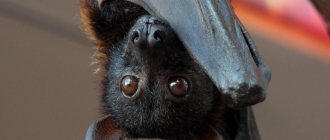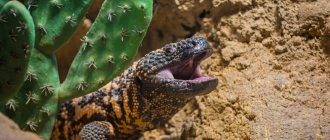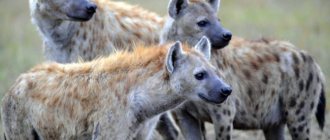The weight of an adult panda is 150 kg
When we imagine a giant panda, we think of cute, clumsy black and white bears. They are funny and it is no wonder that they are loved all over the world.
But what do we really know about pandas? Below we have prepared 13 interesting facts that will help you learn more about these funny animals.
№7
Giant panda cubs are born in August-September. They are very tiny. A newborn baby is approximately 900 times smaller than its mother and weighs no more than 140 grams.
Newborn babies have pink skin and are covered with sparse white hairs. Also, they have no teeth and their eyes are closed. Within a month, the babies acquire a more panda-like appearance. By 2 months, the size of the babies is approaching the size of a newborn human child. At 3 years old, the baby becomes an adult and leaves his mother.
Chi-Chi the panda is the symbol of the World Wildlife Fund
In 1961, one of the founders of WWF (World Wide Fund for Nature), Sir Peter Scott, made the panda the symbol of his organization. This honor fell to the resident of the London Zoo - the panda Chi-Chi, whom we still see on the WWF logo.
Since Peter Scott was not only a scientist, but also an animal artist, he personally drew a stylized portrait of the panda Chi-Chi. This is how one of the most recognizable logos in the world appeared. It is absolutely logical that such a sweet and good-natured animal, which itself needs protection, has become a symbol of the WWF Foundation . Peter Scott himself sometimes joked that he chose Chi-Chi in order to save money, since printing her image required only black and white ink.
№10
Giant pandas are not very good parents. Usually one female gives birth to one child. The gestation period lasts about 90-160 days. If a panda gives birth to twins, she will ignore the weaker child, caring only for the healthier and stronger one. Since children stay with their mothers until they are 3 years old, in the wild a panda can only raise 3-4 cubs in its entire life.
In addition, it is worth noting the high mortality rate among young animals. The main causes of death are disease and accidental crushing by their own mothers.
Interesting facts about pandas (12 photos)
Author: YoFunnyTV
23 July 2022 21:29
Community: Animals
Tags: animals interesting facts animal world pandas facts facts about pandas
13926
12
There is a lot of interesting things in the animal world, and we always want to learn more about our favorites. In this article we will tell you 24 facts about funny and cute pandas.
0
See all photos in the gallery
1. The Chinese name of the panda (Xiongmao) means “cat bear”, and the Latin name Ailuropoda melanoleuca can be translated as “black and white catpaw”. 2. The giant panda became known in the West only in the middle of the 19th century.
0
3. The panda is one of the rarest, poorly studied large animals, which is facilitated by a secretive lifestyle. 4. For a long time, scientists argued about whether pandas belong to the bear or raccoon families. And finally, genetic tests and molecular systematics methods have proven that the panda is a bear, not a raccoon.
×
0
5. Despite their similar lifestyle and similar names, the giant and small panda are not related species. The giant panda belongs to the bear family, and the small panda belongs to the panda family. 6. The panda's closest relative is the spectacled bear, living in South America.
0
7. The genomes of humans and pandas coincide by 68%, and pandas and dogs by 80%. 8. In the natural environment, the giant panda is found only in some western provinces of China (Sichuan, Gansu, Tibet).
0
9. In summer, pandas climb to altitudes of up to 4,000 meters in search of low temperatures, and in winter they can descend to altitudes of 800 meters. 10. Giant pandas measure 1.5 meters in length from nose to tail and weigh between 100 and 150 kilograms.
0
11. The panda has an unusual paw: in addition to the usual 5 fingers, it has a peculiar 6th “finger”, which is actually a modified wrist bone. 12. A panda's tooth is 7 times larger than a human's
0
13. 98% of pandas' diet is bamboo. 14. Every day, a panda spends more than 12 hours eating and eats about 12-15% of its weight.
0
15. A panda digests only about 20% of what it eats. 16. Unlike other bears, the panda does not hibernate.
0
17. The weight of a newborn panda is only one eight-hundredth of the weight of its mother. 18. Pandas often give birth to twins, but after giving birth, the mother panda chooses the stronger baby, and the second one, left unattended, soon dies.
0
19. The cub lives with its mother from one and a half to three years. 20. Pandas are listed in the Guinness Book of Records as the most attractive of rare animals.
0
21. There are only about 1,600 pandas left in the wild. 22. China offers pandas for rent to zoos at a cost of $1 million per year, and cubs born during the arena period are the property of the PRC.
0
23. Panda hunting has been completely banned since 1962, and killing a panda in China can be punishable by death. 24. In China, the panda is declared a national treasure.
Source:
Related links:
- Hidden wonders of nature: examples of perfect camouflage from the animal world
- 20 useless facts that will help you appear smarter
- Why doesn't bright fur stop tigers from hunting?
- Just together: an unexpected friendship between a dog and a duck
- Chinese zoo visitors threw rocks at a panda to try to get it to move.
subscribe to the Animals community
Tags: animals interesting facts animal world pandas facts facts about pandas
Did you like the post? Support Chips, click:
45 1 44
Liked
44 1
7
Partner news
№13
She is the most difficult animal to keep in the zoo. Not in terms of care or anything else, but in financial terms. Due to its limited diet (although pandas themselves are carnivores and are ideally suited for eating meat). The second place in terms of financial costs is occupied by the elephant. She is 5 times more expensive to maintain than an elephant.
Come see the giant panda in China!
Giant panda tours with China Highlights!
We will be happy to organize a trip for you to China to see the giant pandas! Below you will find the most popular panda tours:
- Giant Panda Tours to China: The Most Popular Tours and Answers to Frequently Asked Questions
- Tour-cruise along the Yangtze River with a visit to the Panda Sanctuary: Beijing–Xian–Chengdu–Three Gorges–Shanghai, 14 days
- Chengdu Tours: Giant Pandas, Scenic Scenery, Buddhist Culture, Tibetan Villages
Didn't find a suitable tour program? Let's create your ideal tour to China together: just send a request to our consultants, and they will help you create the optimal tour based on your wishes.
Welcome to China, to visit the giant pandas!
Long debates about the relationship to one or another family
In total, there are 2 types of pandas: large (the second name is “bamboo”) and small (“red”). There have been long debates among scientists about which family animals belong to , but now we can definitely find out the answer to the question.
Despite the fact that both of these species are called pandas, they belong to different families. If the bamboo panda, after lengthy disputes, is still classified as a member of the “ursidae” family, then the situation with the red panda is different - it is classified as a “raccoonidae” (by the way, the bamboo panda was also classified as one for some time).
Big hugs
A few years ago, the Internet was rocked by sensational news, which at first many took as a joke: a research institute located in Sichuan province needed an employee with an official entry in the work book as a “panda hugger.”
There are certain requirements for a person who decides to try his hand at this field: he must be over 22 years old, love and be able to photograph bamboo bears during games and daily procedures, and know enough about their lifestyle and habits. But the most interesting requirement is the desire of the applicant to often hug, cuddle and pick up these animals.
Such work is not easy, since it does not involve weekends or vacations, since the animals will experience stress even from the short-term absence of their friend. But the salary that such an employee is paid allows him to put up with a busy work schedule, since it is 32 thousand dollars a year. Food and accommodation are entirely borne by the research institute, so there is no end to those who want to take this position.
5 / 5 ( 1 voice )
Brown relatives
Did you know that the world famous black and white animals have close brown (or brown) relatives? In 1960, in Shaanxi province, in the Qinling Mountains, a local population with a characteristic “panda” color was discovered. But only they are white-brown, all characteristic spots are brown or brown. They differ from the main species by having a slightly smaller head and larger molars.
Scientists have put forward a theory according to which in this population the recessive gene responsible for brown coloration became dominant as a result of inbreeding. Although the subspecies is little studied, it is classified as separate. The basis for this conclusion was genetic research and an attempt to cross relatives with each other. Although the brown female became pregnant by the black and white male, and even gave birth to three cubs, the offspring turned out to be non-viable.
At the moment, it is believed that the entire subspecies consists of only 300 (or slightly more) individuals. In captivity there is only one male. His mother abandoned him as a baby. The study of the subspecies is complicated by the small number of its representatives, special secrecy and habitat - they skillfully hide in the forests of Qinling at an altitude of 1300 to 3000 meters.
About reproduction
Bamboo bears become sexually mature at the age of 5-8 years. Females are capable of fertilization only a couple of days a year, which complicates the reproduction process, especially in captivity. People are trying their best to somehow help and intensify this process. Several zoos around the world have practiced showing animals videos of sexual intercourse to stimulate their interest in procreation, but this has not brought much results.
Pregnancy lasts 97-163 days. This timing difference is due to the fact that the fetus can temporarily stop developing until the required amount of food, normal temperature and the most suitable conditions for the birth of offspring appear.
There is one curious case associated with pregnancy, which became known throughout the world. The fact is that pregnant females in zoos are treated in a special way; all their whims are immediately fulfilled, which Ai Hin, a panda who was considered pregnant, took advantage of. She diligently pretended to be an expectant mother, was slow, and demonstrated how difficult it was for her to bear the burden of pregnancy. For many months, Ai Hin happily ate the best food provided to her not only by the zoo administration, but also by many viewers who watched the “pregnant” woman on television. When the deception was discovered, the simulator was generously forgiven, since she became a favorite of the public.
How long and where do red pandas sleep?
Like the giant panda, the red panda prefers a crepuscular lifestyle, being active mainly in the evening and sometimes at night. Accordingly, they sleep for the most part during daylight hours.
The red panda is active at dusk, and during the day it sleeps.
Unlike the giant panda, which can sleep anywhere, the red panda prefers cozy and warm cavities. At the same time, she invariably curls up into a ball and covers her eyes with her luxurious tail. When she sleeps, she can easily be mistaken for a fox or a large cat.
Red pandas usually sleep curled up in a neat little red ball.
Sometimes, instead of a hollow, she builds a nest in a tree or simply sleeps, sitting or lounging on a branch. Moreover, when she sleeps while sitting, the red panda hangs her head on her chest right between her front paws. She tries to use all the time free from eating food to sleep.
Very often the red panda sleeps lounging in the branches.
Repertoire
There are many different sounds in the active panda vocabulary. Mothers communicating with their children purr specifically, and the greeting of adults is similar to the chirping of birds. When the animal is hostile, it barks, as large dogs do, and the warning signal resembles a horn.
Scientists have studied in detail the arsenal of sounds made by a bamboo bear. It was possible to establish interesting facts: when bamboo bears begin their mating season, they begin to sing. But these songs sound a lot like bleating. To human ears, these songs are perceived the same, but with the help of such roulades, males tell the “brides” about their size, and females report their age. They may also make “flirtatious” snorts, moans and squeals.
Food lovers
The known name of this species is bamboo bear. However, the diet may include not only plant foods, but also meat “dishes”: small birds, animals and carrion. But bamboo still remains their favorite food. They spend half the day eating bamboo, and during this time they can eat up to 38 kg of stems. The entire digestive system is adapted to such nutrition, therefore, in order not to damage the mucous membrane with chips of a hard plant, it is covered with a thick elastic layer of cells.
Bamboo is a low-calorie product, so animals cannot get much energy from it. It is for this reason that they tend to lead a sedentary lifestyle that helps preserve strength. For the same reason, they do not hibernate, like most of their relatives: plant foods do not contribute to the accumulation of fat reserves, which will allow them to sleep peacefully for a long time.
Fox-bear or Fire Fox
Small and giant pandas are completely different from each other. The big ones look like typical bears, the small ones look more like raccoons or foxes. Red body, black paws, characteristic raccoon colored muzzle and white ears. And, naturally, a long (up to 50 centimeters) tail with white stripes.
This animal has long puzzled scientists: it looks like a raccoon, but calmly climbs trees and descends upside down like representatives of the cat family. When angry, he behaves like an aggressive bear - he attacks on his hind legs. Or arches his back like an angry cat. It feeds on almost only bamboo, 13 hours a day, and only on its soft parts - mainly shoots. It creates holes in hollows, eats with its paws, and practically does not drink (at least, the method of absorption of liquid has not yet been established). And the color resembles a fox. And it is also genetically somewhat similar to martens and skunks. So how to classify such an animal? As a result, they agreed that this is a family of little pandas, which is represented by only two species.
Their difference is their habitat:
- the Little Red Stein lives in northern Myanmar and southern China, and in the provinces of Yunnan and Sichuan;
- the western small red lives in the Himalayas (Nepal and Burma).
The animal leads a predominantly crepuscular lifestyle. It sleeps right on trees or in hollows, covered with a gorgeous tail. He walks poorly, not fully supported by pads, but prefers to eat on the ground: he sits down comfortably or lies on his back.
Interesting. According to the developers of the Fire Fox browser, they wanted to make these animals a symbol. But they were unable to accurately depict the animal; as a result, the symbol looks more like an ordinary fox.
Sexual dimorphism is practically not expressed: males and females are almost the same height (about 60 centimeters) and weight (up to 6 kilograms). But the male occupies almost twice as much territory – 5 and 2.5 square kilometers, respectively. They are solitary by nature, they mark and protect their territory.
Reproduction
A female is capable of conceiving offspring only one day a year, and annually. Pregnancy lasts from 90 to 145 days: immediately after conception, diapause begins, which can last up to 70 days. And for the development of the embryo, 50 days are enough. Babies are born weighing about 100 grams, blind, deaf, with lighter, thin fur.
Babies live with their mother for up to a year; of the newborns (and there can be up to 4), usually only one survives.
Little pandas are also on the verge of survival - there are about 350 of them left in the wild, but there is a chance to survive: they reproduce well in captivity.
So, we found out how bamboo bears and fox-bears are similar and different. These are different subspecies, not related. Big pandas, cute and cute, are well known all over the world. Small ones are no less attractive. But in captivity, especially at home, it will not be possible to keep them. The specific nutrition will not allow the animals to survive. But there is a solution: if you want a pet that looks like a giant panda, take advantage of the achievements of Chinese breeding scientists and get a panda dog. Its color is an exact copy of the famous prototype.
They belong to the order of carnivores, but eat mainly bamboo
The giant panda mainly feeds on bamboo - 98% of the animal's diet consists of it, but despite this fact, it belongs to the classification of "predators" . In addition to bamboo, an animal can diversify its diet by pampering itself with fish, pika or small rodents.
Scientists classified the panda as “carnivorous” after genetic studies. At one time the animal was classified as a raccoon, but in terms of its feeding method it is a herbivorous organism. This beautiful beast may be a vegetarian, but still has all the signs of a predatory animal.
Interesting fact: foxes and wolves also prefer variety in their diet - they love melons. If you have noticed, cats (the “carnivorous” order) sometimes chew grass.











